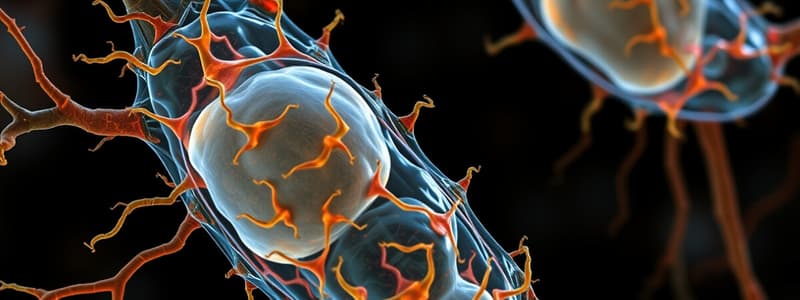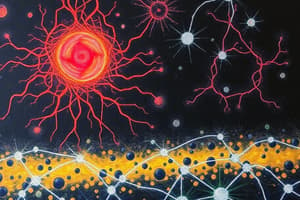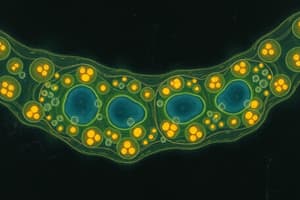Podcast
Questions and Answers
What are communicating junctions primarily responsible for?
What are communicating junctions primarily responsible for?
- Permitting intercellular exchange of substances (correct)
- Providing physical support between cells
- Preventing ion movement between cells
- Maintaining cell shape and structure
Which of the following is true about gap junctions?
Which of the following is true about gap junctions?
- The diameter of the channels is fixed regardless of intracellular signals
- They are found in heart tissue and intestinal epithelial cells (correct)
- They allow the passage of molecules with a molecular weight greater than 1,000
- They consist of a single protein subunit called connexin
How is the diameter of the channels in gap junctions regulated?
How is the diameter of the channels in gap junctions regulated?
- By the concentration of intracellular calcium ions (correct)
- Primarily by temperature changes
- Through mechanical stretching of the cell membrane
- By external pressure applied to the cell
What is the main function of chemical synapses?
What is the main function of chemical synapses?
What is the size of the intercellular space at gap junctions?
What is the size of the intercellular space at gap junctions?
What do connexins or connexons comprise in gap junctions?
What do connexins or connexons comprise in gap junctions?
Which substances can pass through gap junctions?
Which substances can pass through gap junctions?
What happens to the diameter of gap junction channels when intracellular calcium concentration increases?
What happens to the diameter of gap junction channels when intracellular calcium concentration increases?
Flashcards are hidden until you start studying
Study Notes
Communicating Junctions
- Permits intercellular exchange of ions and molecules.
- Includes gap junctions and chemical synapses.
Gap Junctions
- Also known as nexus.
- Facilitate direct passage of ions and smaller molecules between adjacent cells.
- Found in the heart and basal epithelial cells of the intestinal mucosa.
Structure of Gap Junctions
- Membranes of adjacent cells are closely aligned, reducing the intercellular space to 2.5 to 3 nm.
- Cytoplasm of cells is interconnected via channels formed by membrane proteins.
- Channel structure consists of two halves, each made of six protein subunits called connexins or connexons.
- Channel diameter ranges from 1.5 to 3 nm, allowing passage of substances with molecular weight less than 1,000.
Functions of Gap Junctions
- Enables exchange of chemical messengers between cells.
- Facilitates rapid propagation of action potentials between cells.
- Diameter of the channel is regulated by intracellular calcium ion concentration, pH levels, electrical potential, hormones, and neurotransmitters.
Chemical Synapse
- Junction between a nerve fiber and a muscle fiber or between two nerve fibers.
- Signal transmission occurs through the release of chemical transmitters.
Studying That Suits You
Use AI to generate personalized quizzes and flashcards to suit your learning preferences.



